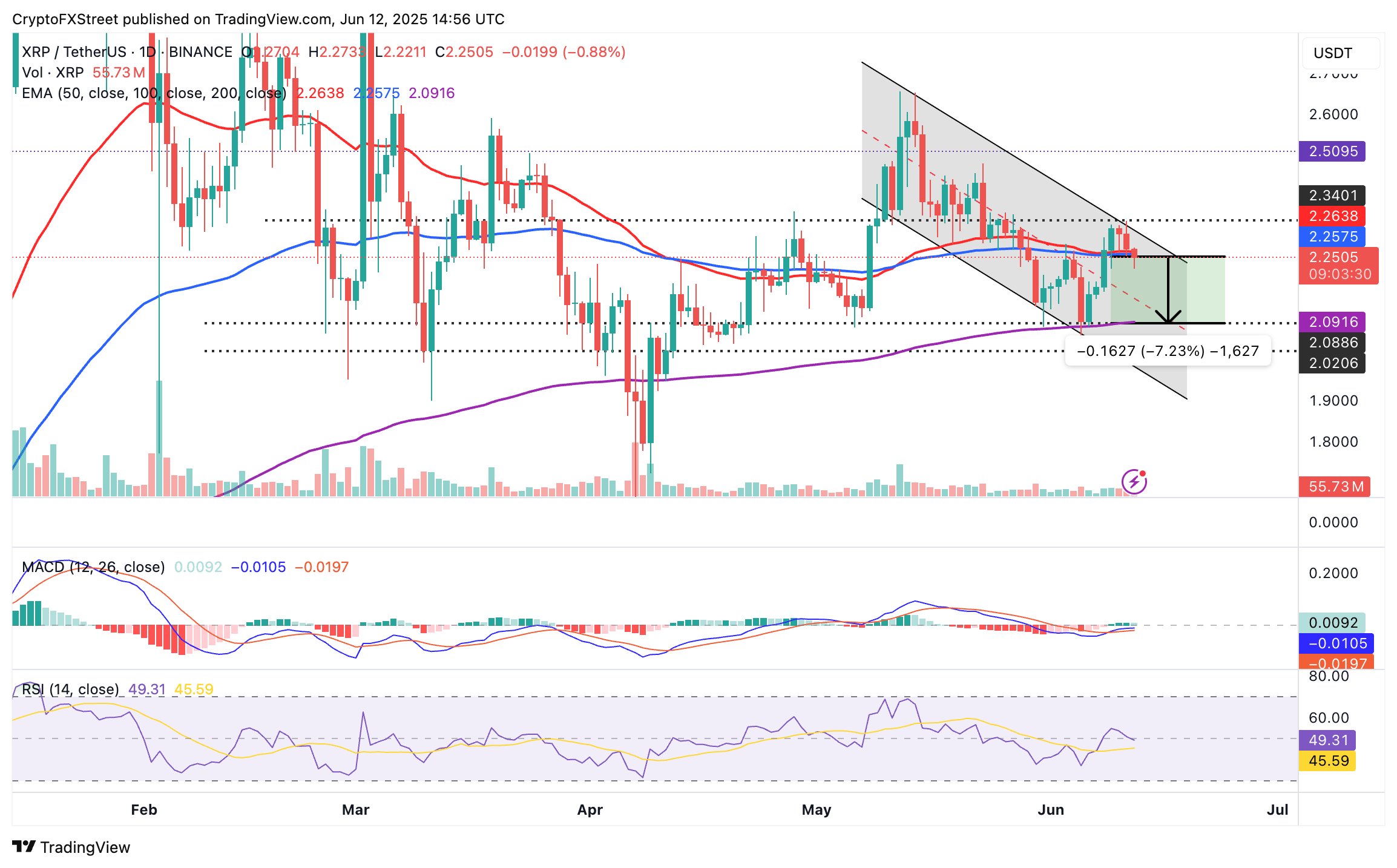- XRP’s decline gains momentum below a confluence resistance formed by the 50-day EMA and the 100-day EMA.
- Ripple CEO Brad Garlinghouse sees the XRP Ledger capturing 14% of SWIFT’s global liquidity within five years.
- Institutional interest surges as Singapore-based Trident announces a $500 million XRP Treasury.
Ripple (XRP) continues to lose ground, signaling a decline in interest in the broader cryptocurrency market. The upside-heavy international money transfer token hovers at around $2.25, down nearly 1% at the time of writing on Thursday and 15% from its previous peak of $2.65, which was reached on May 12.
XRP’s persistent declines mirror the lethargic sentiment that followed the trade talks between the United States (US) and China, which failed to move crypto prices despite the two sides agreeing on a framework that raises the US tariff on China to 55% and gives Chinese students access to US higher education institutions.
Ripple’s XRP Ledger eyes SWIFT’s global liquidity
Ripple’s CEO, Brad Garlinghouse, expressed optimism during the XRP Ledger Apex 2025 summit, saying that the blockchain protocol, known for facilitating cross-border money transfers, could capture up to 14% of SWIFT’s global liquidity over the next five years.
SWIFT is a global messaging network used to facilitate communication between financial institutions. The system allows banks, payment providers and other financial entities to trade information about financial transactions, including money transfers, payments and securities settlements across international borders.
RippleNet, Ripple’s flagship network for payments, currently boasts hundreds of partner banks globally. However, the blockchain startup only allows a handful of players to tap into the On-Demand Liquidity (ODL) system, which uses XRP. The financial institutions utilizing ODL include MoneyGram, Santander and SBI Holdings.
“SWIFT today has two components: Messaging and liquidity,” Garlinghouse stated. “Liquidity is owned by banks. I think less about the messaging and more about liquidity. If you’re driving all the liquidity, it’s good for XRP. So, in five years, I’d say 14%,” he added.
Ripple and the XRP Ledger (XRPL) have been mentioned in discussions regarding potential alternatives to SWIFT or their integration into conventional platforms, citing the protocol’s low cost and high transaction throughput.
Still, such an integration remains highly unlikely, considering SWIFT is moving toward blockchain adoption. The payments platform eyes the integration of blockchain technology in the upcoming ISO 20022 upgrade, expected in November.
XRP captures institutional interest
Interest in XRP and related financial products is on overdrive, with institutions launching treasury fund strategies. In a report published by GlobalNewswire, Trident Digital Tech Holdings (NASDAQ: TDTH), a company that spearheads technology optimization services and Web3 activation, has announced a $500 million XRP Treasury.
The Singapore-based company also appointed Chaince Securities LLC as the strategic advisor for the fund. Trident, through the fund, will acquire XRP tokens as part of a long-term strategic reserve while diversifying into staking mechanisms to generate yield.
Trident expects the initial rollout of the initiative to start in the second half of the year, subject to regulatory approval, compliance and market conditions.
“Through this initiative, Trident aims to demonstrate how public companies can thoughtfully and responsibly participate in the ongoing development of decentralized finance,” Soon Huat Lim, Trident’s founder and CEO, said in a press release.
Technical outlook: XRP downside risks could escalate
XRP is currently trading below a recently broken support level, which is now acting as short-term resistance at around $2.26. The hurdle brings together the 50-day Exponential Moving Average (EMA) and the 50-day EMA, forming a confluence.
Should the price of XRP close below the confluence resistance, downside risks could escalate, potentially extending the decline by 7% to the next key support provided by the 200-day EMA at $2.09.
The Relative Strength Index (RSI) has retreated slightly below the 50 midline from highs around 54, signaling that bearish momentum is building.

XRP/USDT daily chart
Still, traders may want to temper bearish expectations, considering the Moving Average Convergence Divergence (MACD) has sustained a buy signal since Monday. This signal manifests with the blue MACD line crossing above the red signal line.
The MACD buy signal has the potential to encourage traders to continue buying XRP, thereby strengthening the tailwind on the token and increasing the likelihood of a breakout above the descending channel illustrated on the chart. Key areas of interest to traders include the seller congestion at $2.34, $2.50 and $2.65.

























